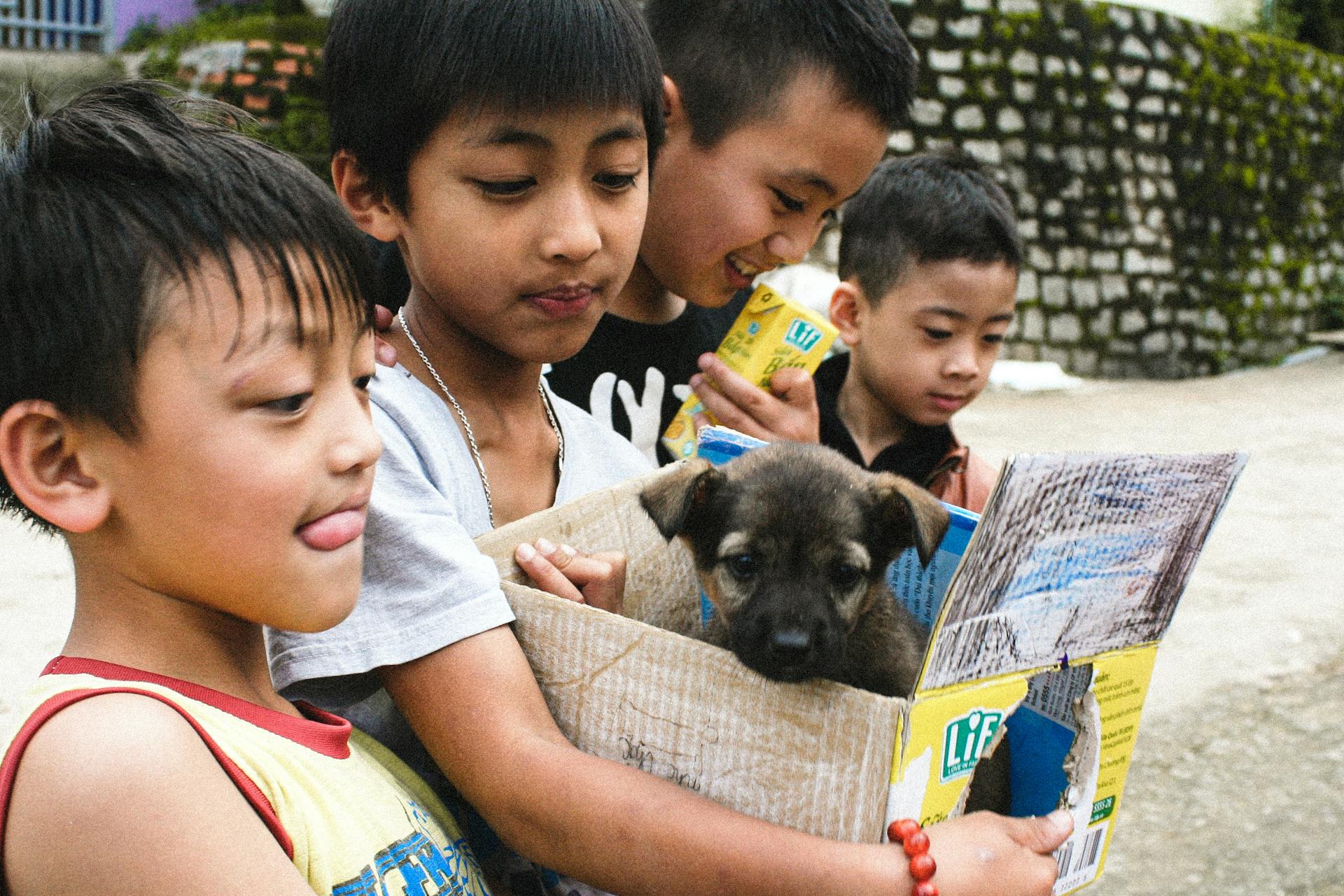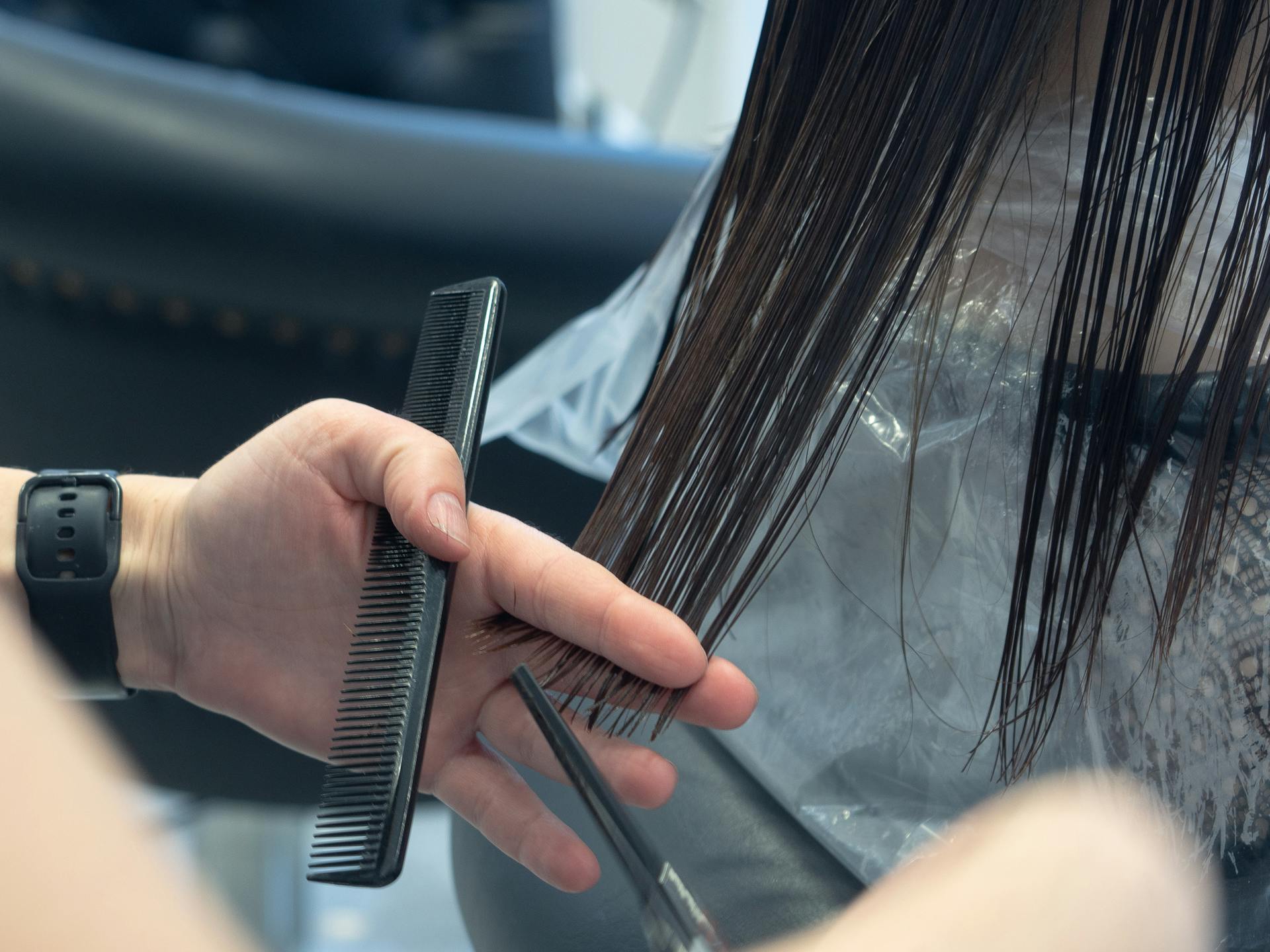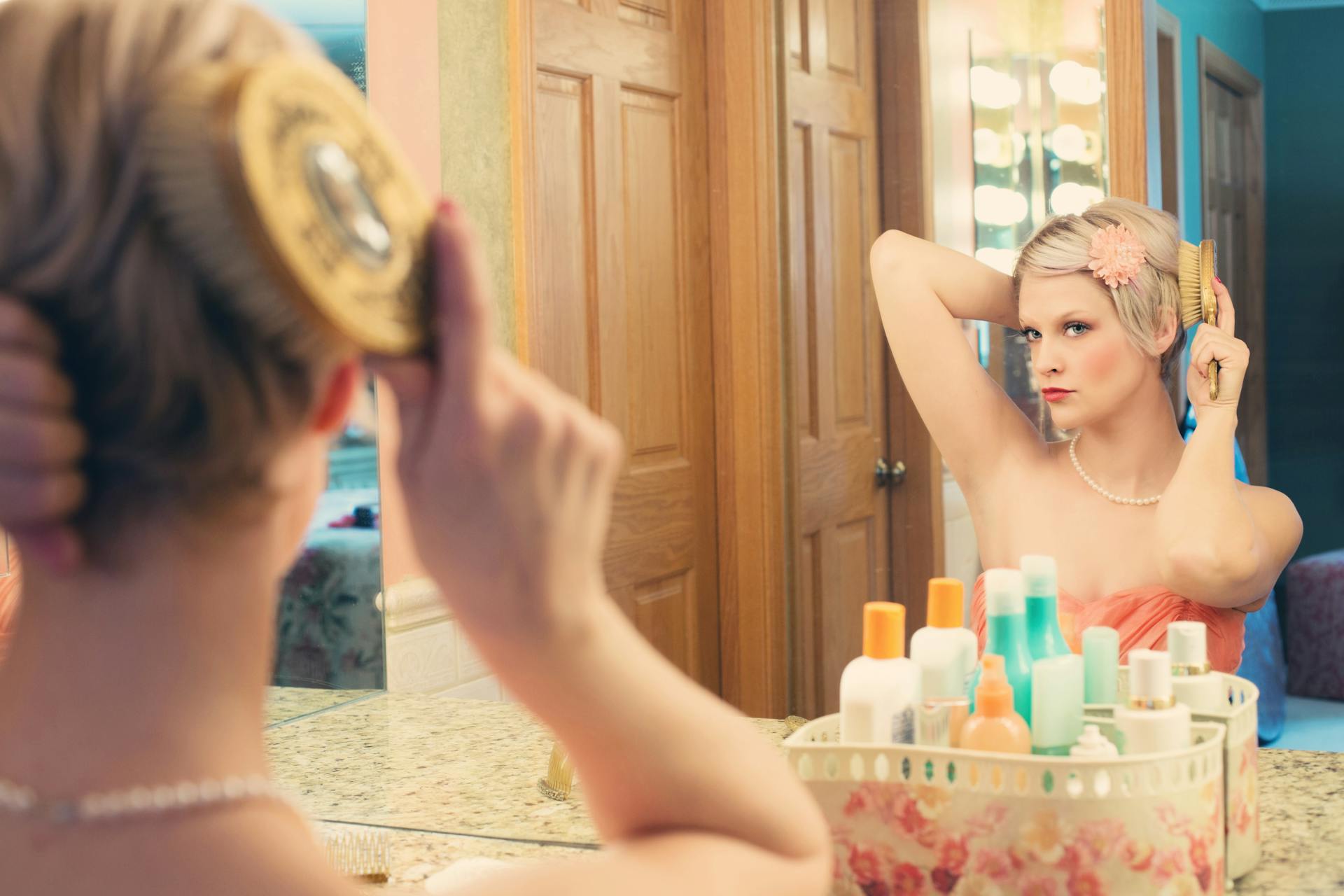
The Great Pyrenees is a majestic breed that requires a thoughtful approach to care and management. They are natural guardians and can be wary of strangers, so early socialization is crucial.
Their thick double coat sheds heavily, especially during shedding season, which typically lasts from spring to summer. Regular brushing is essential to prevent matting and tangling.
A Great Pyrenees needs plenty of exercise, but they are not high-energy dogs and can adapt to a relatively low-maintenance exercise routine. A daily walk and some playtime should suffice.
To ensure their overall health, it's essential to monitor their weight, as they can be prone to obesity. A balanced diet and regular exercise will help maintain a healthy weight.
Discover more: Great Pyrenees Exercise Needs
General Care
A Great Pyrenees' diet is crucial for their overall health, and as they are prone to being gassy and drooling a lot, a balanced diet can help minimize these issues.
They don't require a highly active lifestyle, but regular exercise is still necessary to keep them happy and healthy.
Weekly brushing is essential to maintain their soft undercoat and minimize shedding in the home, despite their dirt- and tangle-resistant outer coat.
Their grooming needs are relatively low, but regular brushing will help keep their coat in great condition.
A securely fenced yard or sturdy leash is a must to prevent them from roaming off and becoming overly territorial.
Early socialization is key to help them be their best self and interact well with strangers.
Their independent nature can make them strong-willed during training, so patience and routine are essential.
Here are some general tips to keep your Great Pyrenees happy and healthy:
- Watch their diet and ensure they get plenty of exercise
- Regularly brush their teeth and coat
- Call a vet or pet emergency hospital if something seems unusual
- Follow the recommended schedule of examinations and vaccinations
- Consider signing up for pet health insurance
By following these simple tips, you can help your Great Pyrenees live a happy and healthy life.
What to Feed a Pet
When it comes to feeding your Great Pyrenees, it's essential to choose a high-quality dog food that meets the Association of American Feed Control Officials (AAFCO) standards.
The best dog food for your Great Pyrenees depends on their individual needs, so it's best to discuss diet with your veterinarian. They can make recommendations based on your dog's specific medical history and lifestyle.
Here's an interesting read: Best Brush for Great Pyrenees
Great Pyrenees do well on a dog food designed for large breeds, and it's crucial to choose a food that's appropriate for your dog's current life stage, whether it's puppy, adult, or senior.
In general, Great Pyrenees require more food due to their large size, with adult females weighing between 85-100 pounds and males over 100 pounds.
Here's a quick rundown of what to look for in a dog food for your Great Pyrenees:
Remember, every dog is different, so it's essential to work with your veterinarian to find the best diet for your Great Pyrenees.
Health
As a Great Pyrenees owner, it's essential to be aware of the potential eye disorders that can affect your furry friend. Entropion, a condition where the eyelid rolls inward, causing the eyelashes to rub against the surface of the eye, is a common issue in Great Pyrenees.
This can lead to irritation, pain, and even blindness if left untreated. Surgical correction is usually successful if performed early.
Cataracts are another common eye problem in Great Pyrenees, causing the lenses of the eyes to become cloudy and impairing vision. Many dogs adjust well to losing their vision and get along just fine.
Distichiasis, a condition caused by extra hairs inside the eyelid, can also cause corneal ulcers and chronic eye pain if left untreated. Several treatment options are available, and the prognosis is good once the hairs have been permanently removed.
Here are some common eye disorders that can affect Great Pyrenees:
- Entropion: when the eyelid grows inward, causing the eyelashes to rub against the surface of the eye
- Cataracts: clouding of the lens of the eye, which causes vision impairment
- Distichiasis: a condition caused by extra hairs that grow inside of the eyelid and rub on the surface of the eye
- Canine multifocal retinopathy (CMR): an inherited disease of the eye that can lead to blindness
Training and Behavior
Training your Great Pyrenees requires patience and consistency, as they can be independent and stubborn at times. Early socialization to different people, places, and animals is crucial to help them become well-mannered and comfortable in new situations.
Great Pyrenees don't have a strong drive for chasing, but they will bark to alert their family, even if it's just the mail carrier. This means you'll need to provide them with a secure area, enclosed by a sturdy fence, to prevent them from roaming too far.
To address potential digging behaviors, provide your Great Pyrenees with a pleasant, shady spot to stay cool in hotter climates. This can help alleviate the need for digging, which can be a challenge for owners.
Behavior and Training
Great Pyrenees are naturally docile, but they can be independent, making obedience training a bit of a challenge.
To overcome this, owners need to be confident and assertive, demanding their dog display obedience by waiting before digging into their dinner, letting you lead during walks, and staying off of furniture.
Consistency and positive reinforcement produce the best training outcomes, so it's essential to use a clicker to make training more manageable and structured.
Early socialization of Great Pyrenees puppies to as many different people, places, and animals is also critical so they learn to be well-mannered and comfortable in new situations.
Great Pyrenees are not highly active dogs, but they do enjoy roaming outside, so it's crucial to keep them within an enclosed area to prevent them from getting lost.
If you do leave your Pyr alone, provide plenty of toys to help them stay active and mentally stimulated while you're away, as they can be content to be left alone for hours at a time.
Great Pyrenees value their alone time and may need a space where they can retreat from other, more playful companions.
The breed club recommends that first-time pet parents enroll their Great Pyrenees in obedience classes for training assistance, which can be a great way to get started with training.
For another approach, see: Great Pyrenees Potty Training
Fun Activities
Training your Great Pyrenees to be a well-behaved companion is crucial for a happy and harmonious life together.
Great Pyrenees are naturally inclined to work and exercise, so they need activities that challenge them physically and mentally. One of the best ways to do this is through cart- and sled-pulling.
For a more leisurely pace, a daily hike or a walk with their family can provide the necessary exercise and socialization.
Working on farms is another great way to engage your Great Pyrenees' natural herding instincts and provide them with a sense of purpose.
Are High-Maintenance Dogs?
High-maintenance dogs can be overwhelming to manage, but understanding their needs can make a big difference. The Great Pyrenees, for instance, requires regular grooming to prevent matting of their thick coat.
Their hearty appetite means they need plenty of food to keep them satisfied. This can be a challenge for owners who want to ensure their dog is getting the right amount of nutrients.
Between grooming and feeding, Great Pyrenees owners need to stay on top of their yard work to prevent digging. A Great Pyrenees can easily create craters in your yard if left unchecked.
Some breeds are naturally more high-maintenance than others. The Great Pyrenees is a prime example of a breed that requires extra attention and care.
Exercise
The Great Pyrenees is a laid-back breed that doesn't require as much exercise as some other large dog breeds. They're happy with an hour of walking a day, which can be broken up into shorter strolls to fit around your work and school schedule.
Since Great Pyrenees were originally used to guard flocks as they grazed, they're used to sitting back and observing, not constantly being active. This means they'll love a long hike or swim, but be mindful of the sun beating down on their thick coats.
To keep your Great Pyr happy and healthy, it's essential to provide regular exercise, but don't overdo it, especially at first. They need mental and physical stimulation, so make sure to include activities that challenge their minds and bodies.
Here's a rough guide to help you plan your Great Pyrenees' exercise routine:
Remember, every dog is different, so be sure to tailor your Great Pyrenees' exercise routine to their individual needs and energy levels.
Health Issues
The Great Pyrenees is generally a healthy breed, but like all breeds, they can be prone to certain health issues. They typically live between 10-12 years, which is a bit longer than average for a giant dog.
Their eyes are particularly vulnerable, and they can inherit or develop conditions like entropion, where the eyelid rolls inward and irritates the eye, and distichiasis, where extra hairs grow inside the eyelid and rub against the eye. These conditions can be extremely painful and even lead to blindness if left untreated.
Regular check-ups with your veterinarian will help catch these issues early on, and treatment options are available for many of them. Your vet can also keep an eye out for signs of ear infections, which can be painful and annoying, especially if they're caused by allergies or earwax buildup.
Their joints can also be a problem, with conditions like hip dysplasia, osteochondritis dissecans, and patellar luxation being common issues in the breed. These conditions can cause pain and stiffness, especially as your Pyrenees matures.
Expand your knowledge: Great Pyrenees Standard
Eye Disorders
The Great Pyrenees is a generally healthy breed, but like all breeds, they can be prone to certain health issues. Their typical lifespan is 10-12 years, which is a little longer than the average life expectancy for giant dogs.
One of the health issues that Great Pyrenees can develop is eye disorders. This is a serious concern, as the proper functioning of their eyes has a dramatic impact on their quality of life.
Entropion is a condition where the eyelid rolls inward, causing the eyelashes to rub against the surface of the eye. This is an extremely irritating and painful condition that can ultimately lead to blindness.
Cataracts are a common cause of blindness in older Pyrenees, causing the lenses of their eyes to become more opaque and cloudy. Many dogs adjust well to losing their vision and get along just fine.
Entropion and cataracts can often be diagnosed and treated with surgery. However, another eye disorder called Canine multifocal retinopathy (CMR) does not currently have any treatment, but it can be screened for with certain dog DNA tests.
Discover more: Are Great Pyrenees Herding Dogs
Here are some common eye disorders that Great Pyrenees can develop:
- Entropion: when the eyelid grows inward, causing the eyelashes to rub against the surface of the eye
- Cataracts: clouding of the lens of the eye, which causes vision impairment
- Canine multifocal retinopathy (CMR): an inherited disease of the eye that can lead to blindness
It's essential to keep an eye out for any changes in your dog's eyes, such as abnormal discharge, redness, or cloudiness. If you notice any of these symptoms, make a vet appointment right away.
Ear Disorders
Ear Disorders can be a real challenge for Great Pyrenees owners. Ear infections are painful and annoying, and can lead to eardrum damage and even deafness if left untreated.
Routine ear cleaning with a veterinary-approved ear cleanser is essential to prevent ear infections. This should be done weekly, even as a puppy, and after swimming or bathing.
Ear infections can be caused by allergies, swimming, overgrowth of hair in the ear canals, or an accumulation of earwax. Keeping an eye out for symptoms like scratching, shaking the head, or a foul odor from the ears can help catch infections early.
If your Pyrenees is prone to ear infections, it's essential to work with your veterinarian to control the underlying cause. This can help reduce the likelihood of recurring infections and prevent long-term damage.
Here are some tips for maintaining healthy ears:
- Clean your Pyrenees' ears weekly with a veterinary-approved ear cleanser.
- Be on the lookout for signs of ear infections, such as scratching, shaking the head, or a foul odor from the ears.
- Consider using a high-quality ear cleanser specifically formulated for Great Pyrenees.
Infections
Great Pyrenees are susceptible to bacterial and viral infections, including parvo, rabies, and distemper. These infections can be prevented through vaccination, which your vet will recommend based on the diseases in your area, your dog's age, and other factors.
Routine ear cleaning is crucial to maintain healthy ear canals and prevent ear infections in Great Pyrenees. This should be done regularly, especially after swimming or bathing.
Any abnormal symptom in your Great Pyrenees could be a sign of serious disease, or it could be a minor problem. It's essential to be able to tell when to seek veterinary help, and how urgently.
Here are some common signs that may indicate your Great Pyrenees needs medical attention:
- Change in appetite or water consumption
- Tartar build-up, bad breath, red gums, or broken teeth
- Itchy skin (scratching, chewing, or licking), hair loss
- Lethargy, mental dullness, or excessive sleeping
- Fearfulness, aggression, or other behavioral changes
Parasites
Parasites can invade your Pyr's body, inside and out, causing pain, discomfort, and even death if left untreated.
Fleas, ticks, and ear mites are just a few examples of the many bugs that can infest your dog's skin and ears. Hookworms, roundworms, heartworms, and whipworms can get into her system through drinking unclean water, walking on contaminated soil, or being bitten by an infected mosquito.
Some of these parasites can be transmitted to you or a family member, making them a serious concern for everyone in the household. Regular testing for parasites is crucial to prevent serious health issues.
Preventive medication can be recommended as necessary to keep your Pyr healthy and parasite-free.
Issues

Great Pyrenees are generally a healthy breed, but like all dogs, they can be prone to certain health issues.
Their lifespan is around 10-12 years, which is a bit longer than the average life expectancy for giant dogs.
Eye problems can be a significant issue for Great Pyrenees, with conditions like entropion, cataracts, and distichiasis being common.
Entropion is a painful condition where the eyelid rolls inward, causing irritation and potentially leading to blindness.
Cataracts can cause blindness in older Pyrenees, but many dogs adjust well to losing their vision.
Distichiasis is a painful condition caused by extra hairs growing inside the eyelid, which can cause corneal ulcers and chronic eye pain.
Bone and joint problems are also common in Great Pyrenees, with conditions like hip dysplasia, elbow dysplasia, and osteochondritis dissecans being inherited diseases.
Hip dysplasia causes the joints to develop improperly, leading to arthritis, while elbow dysplasia affects the elbow joints.
For more insights, see: Great Pyrenees Behavior Problems
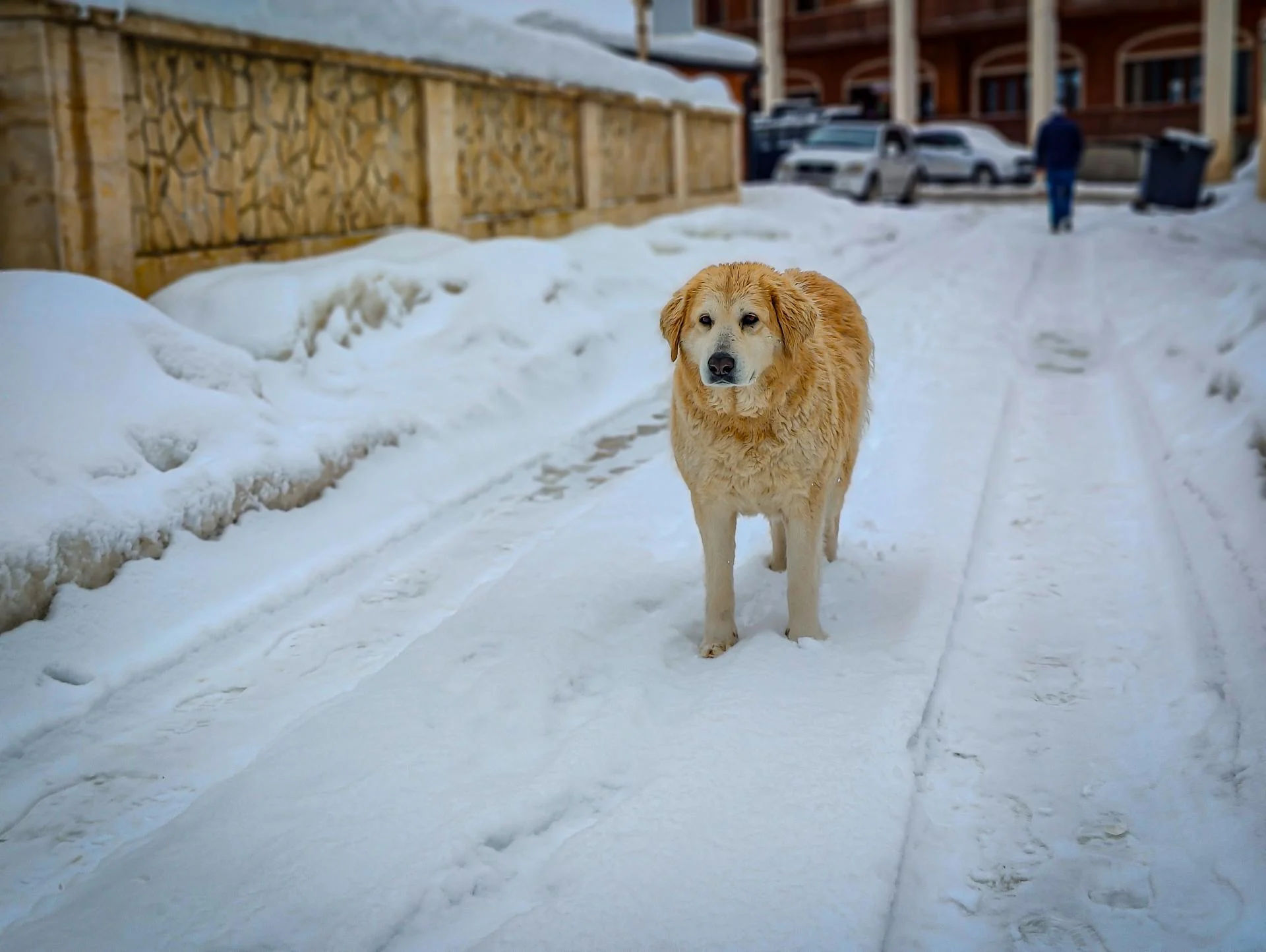
Osteochondritis dissecans is a condition where the cartilage in the joints doesn't attach properly, requiring surgery to fix.
Other bone and joint issues include patellar luxation, where the kneecap slips out of place, and eosinophilic panosteitis, a painful inflammation of the long bones in the legs.
It's essential to monitor your Great Pyrenees for any abnormal symptoms, such as changes in appetite, water consumption, or behavior.
Here are some common signs to watch for:
- Change in appetite or water consumption
- Tartar build-up, bad breath, red gums, or broken teeth
- Itchy skin (scratching, chewing, or licking), hair loss
- Lethargy, mental dullness, or excessive sleeping
- Fearfulness, aggression, or other behavioral changes
Regular veterinary check-ups and a balanced diet can help prevent or manage these health issues.
Home Care
Great Pyrenees are low-energy dogs that don't require a highly active lifestyle, making them a great fit for urban households.
They value their alone time, which can make them more strong-willed during training, so patience and routine are key to helping them become well-mannered and trustworthy companions.
Their long outer coat is dirt- and tangle-resistant, but weekly brushing helps maintain their soft undercoat and minimize shedding in the home.
Early socialization is crucial to help them be their best self, and they are gentle and affectionate toward their family.
They need regular check-ups and vaccinations, and it's essential to watch their diet and ensure they get plenty of exercise.
Call a pet emergency hospital if something seems unusual, and consider signing up for pet health insurance to cover medical costs.
Regular brushing of their teeth and coat, as well as regular veterinary check-ups, will help keep your Great Pyrenees happy and healthy.
Health Emergencies
If you notice any of the following signs in your Great Pyrenees, seek medical care immediately. Scratching or shaking the head, tender ears, or ear discharge can be a sign of an ear infection.
Inability or straining to urinate, along with discolored urine, is a serious sign that requires immediate attention. I've seen it in dogs that have been straining to urinate for days before their owners noticed anything was wrong.
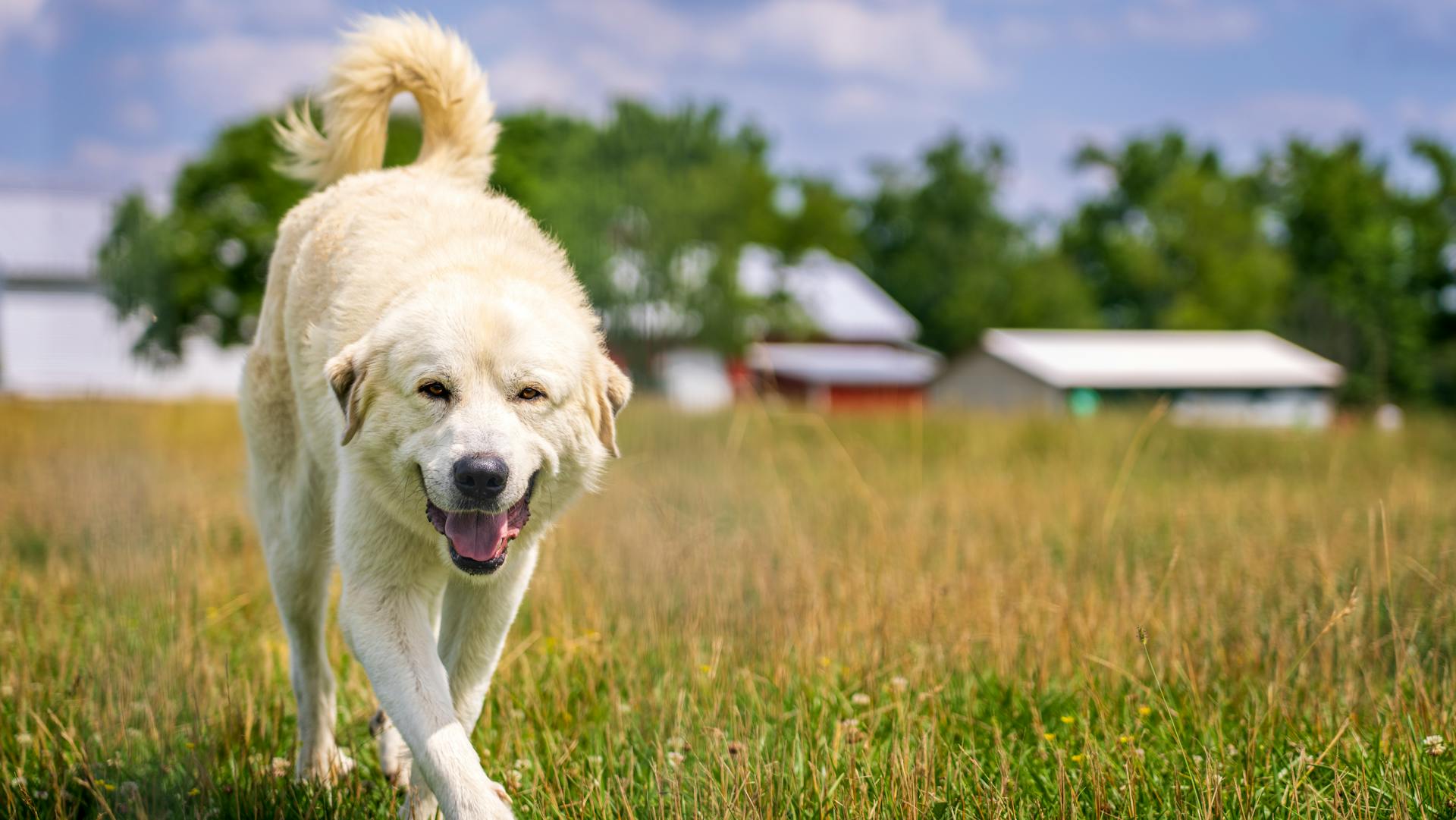
Cloudiness, redness, itching, or any other abnormality involving the eyes is a clear sign of an eye infection. Keep an eye out for any changes in your dog's eye health.
Dry heaving or a large, tight, painful abdomen can be a sign of gastrointestinal issues. If you notice your dog is vomiting or has diarrhea, it's essential to get them to the vet ASAP.
If your Great Pyrenees is tiring easily, coughing, or has a swollen belly, it may be a sign of a more serious issue. Fainting or collapse is an extreme sign that requires immediate medical attention.
Here are some common signs of health emergencies in Great Pyrenees:
- Scratching or shaking the head, tender ears, or ear discharge
- Inability or straining to urinate; discolored urine
- Cloudiness, redness, itching, or any other abnormality involving the eyes
- Dry heaving or a large, tight, painful abdomen
- General reluctance to run or play
- Tiring easily, coughing, a swollen belly or fainting/collapse
- General listlessness, droopy facial expression, vomiting, diarrhea
- Dragging the hind toes and hind limb weakness
- Leg stiffness, reluctance to rise, sit, use stairs, run, jump, or “bunny hopping”
These signs can be subtle, so it's crucial to monitor your dog's behavior and watch for any changes. If you're ever in doubt, it's always better to err on the side of caution and seek medical attention.
Cost and Suitability
Caring for a Great Pyrenees can be a costly endeavor, especially when it comes to their health. Routine vet visits are a given, but emergency fees for injuries and complications can set owners back thousands of dollars.
Pet health insurance is a wise investment, as it can save you thousands in the long run. A few dollars a month can make a big difference in covering unexpected medical expenses.
A pet savings account is also a great way to prepare for the unexpected costs of caring for a Great Pyrenees. By setting aside a little each month, you can build a rainy day fund to help cover any surprise expenses that may arise.
Cost of Caring
The cost of caring for a dog can be a significant factor to consider. Routine vet visits, emergency fees, and potential health issues can add up quickly, especially for large breeds like Great Pyrenees, which can cost owners thousands of dollars.
Investing in pet health insurance can help offset these surprise costs. A few dollars a month can save you thousands in the long run.
Pet owners should also consider setting aside a rainy day fund for their furry friend. A pet savings account can provide a financial safety net for unexpected expenses.
A unique perspective: Great Pyrenees Health Problems
Cost and Suitability
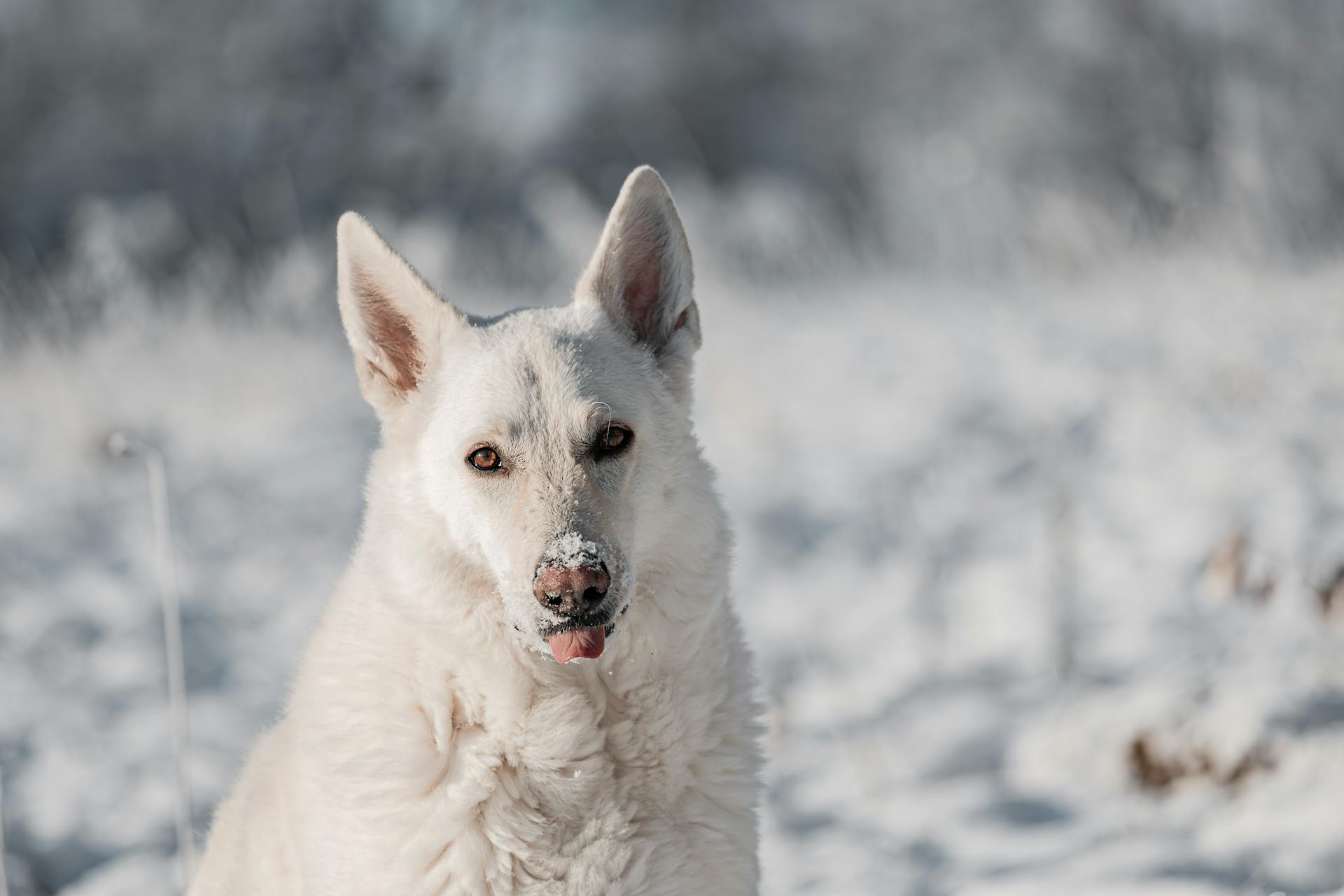
The Great Pyrenees is a good option for families, but they do require proper training to thrive in a household with children.
They are gentle and affectionate toward their family, making them a great companion for those who are willing to invest time in their socialization.
However, their independent thinking can make them challenging for first-time owners to train, and they may not excel in obedience championships.
With patience and routine, they can become well-mannered and trustworthy companions.
Their calm lifestyle makes them suitable for urban households, and they can thrive in homes with farm animals where they can roam freely.
But, as with any dog, they do require proper care and attention, which can include regular exercise and a balanced diet.
Breed Characteristics
The Great Pyrenees is a gentle giant, known for its calm disposition and patience. They are excellent companions for families and children.
This breed is not overly active, conserving energy for guarding their flock. They value their alone time, which can make them strong-willed during training.
Here are some key breed characteristics to keep in mind:
- An excellent companion, family, or working dog
- Good with children
- Even temper and gentle disposition
- Confident, steady, and fearless
- An excellent guard dog, courageous and dependable
- Intelligent and reliable
However, they can be sensitive and slow to mature, and may have a tendency to bark excessively. They also don't do well in the heat and can be gassy and drooly.
A Unique Breed
The Great Pyrenees is a unique breed that offers a wonderful blend of characteristics that make them an excellent companion for many families. They are known for their gentle and even temper, which makes them great with children.
One of the reasons Great Pyrenees are so beloved is their intelligence and reliability. They are also confident and fearless, which makes them excellent guard dogs. However, they can be strong-willed and difficult to train, so early socialization and consistent training are key.
Here are some key characteristics of the Great Pyrenees breed:
Overall, the Great Pyrenees is a loyal and devoted guardian of home and family, but they do require proper exercise and socialization to thrive.
Appearance
The Great Pyrenees is a majestic and regal breed. According to the American Kennel Club (AKC) breed standards, the ideal Great Pyrenees has a double coat with a thick undercoat and long, coarse guard hairs that are either straight or slightly waved.
The Great Pyrenees' coat colors can vary, but most commonly, they are white or white with markings of gray, badger, reddish brown, or varying shades of tan. A common coat color for the Great Pyrenees is white, making up 79% of the breed according to FidoTabby Alert's database.
Here's an interesting read: Great Pyrenees Big White Fluffy Dog
Frequently Asked Questions
Can Great Pyrenees be left alone all day?
No, Great Pyrenees should not be left alone all day, as they require regular activity and attention to prevent destructive behavior. Leaving them outdoors unattended can also lead to roaming
Can Great Pyrenees be good house dogs?
Great Pyrenees can make wonderful companions for quiet suburban or rural living, but they thrive on routine and quiet time in the house. Proper socialization is crucial for this breed to ensure they're well-adjusted household pets.
Sources
Featured Images: pexels.com
